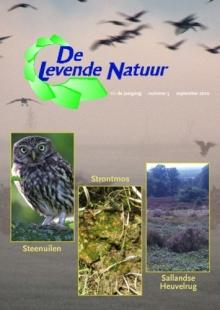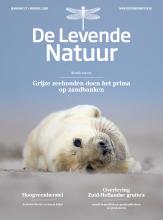De Levende Natuur nummer 5 van 2010 (English summary)
Afbeelding

Little Owls in a changing landscape
P. Fuchs & J.A.J. van de Laar
During 1972-1989 a population of Little Owls was studied in the Central Betuwe, an area between the Lower Rhine and Waal rivers in the province of Gelderland measuring 100 km2 (fig.1). The study was carried out to reveal the consequences of changes in landscape (a.o. the rapid disappearance of traditional orchards) and agricultural practice on structure and functioning of the Little Owl population involved. In this article we focus on the dynamics within breeding territories: trends in choice of nesting locations, fidelity of partners to each other and to once chosen territories, as well as differences in productivity of territories. In accordance with the large scale cutting of orchards (in 1987 circa 42% of the formerly known nesting locations in natural holes appeared to have gone) we found a shift in relative preference of nesting locations from holes in trees to nest boxes. Individuals and couples as well stayed mainly in their territory during all their life. Most movements to other territories could be related to the cutting of nesting trees and in some occasions to high mortality rates in severe winters. Less than half of all 229 identified territories contributed to the maintenance of the local Little Owl population; from one territory, situated in one of the best parts of the study area, even seven fledglings succeeded in obtaining a position as breeding bird. Against the end of the study period in 1989 the Little Owl population in the Central Betuwe was still relatively thriving, though under pressure. They became more dependent on nest boxes. This dependence has grown all over the country ever since. A nest box alone doesn’t make a good habitat, however. It is argued that measures aiming at a better protection of the Little Owl should pay attention to food availability and coverage against predation (especially for young birds in the first weeks after fledgling) as well as to risks concerning traffic accidents.
Framework of nature areas on map 2010
T.F. de Boer, W.S. van Wingerden & J.J. Smit
Government and non governmental organizations in The Netherlands work together to implement a national ecological framework of nature areas by purchasing agricultural land and turning it into nature areas. Discussion is going on about the progress of the implementation program. Because of an agreement in 2007 between the national and provincial authorities, aimed at decentralization of budgets, the Government Service for Land and Water Management developed a clear set of definitions and monitored the program in 2007 and 2010. The results, presented on digital maps, illustrate that the framework probably will not be completed, as stated politically, in 2018. Suggestions are given to accelerate the implementation.
Different sampling methods compared on the heathlands in Salland
A. Aptroot, R. de Beer, J.C.P.M. van de Sande, D. de Boer & J.P.C. van der Goes
The heathlands in Salland, mainly known for the last Dutch population of the Grouse, has a considerable floristic value. This was found with a detailed sampling method. The results of various different sampling methods and intensities are compared. Grid-based methods failed to find most of the rarities. Even after 280 regularly dispersed vegetation relevées were made, less than 6 % of the Red Listed species present had been found.
The joyful return of a dung moss
R.J. Bijlsma
The dung moss Splachnum ampullaceum belongs to the only moss family in which entomophily is known. Species from this family are confined to substrates of animal origin, especially in arctic, boreal and montane regions. In the 19th century Splachnum ampullaceum had a scattered distribution in wet heaths, bogs and fens in the Northwest European lowland, but virtually disappeared here in the course of the 20th century. In The Netherlands it has been recorded five times, for the last time in 1910. Since the sticky spores are distributed by flies, a return of this dung moss was not anticipated. However, in 2010 it was found on cow dung in the Witterveld near Assen (prov. of Drenthe), a military terrain and Natura2000 site with well-developed bog and wet heath vegetations. The heathlands are grazed by cows since 1990. It seems unlikely that Splachnum survived for many decades in this area in the absence of large herbivores. Therefore, the author speculates that small clumps of spores (3-4 spores together have the size of one peatmoss spore) arrived by long distance wind dispersal.
Relations between management and breeding bird populations in a grassland area
W.H.M. van Boekel, J. de Bruin, J. Poortstra & A. van der Spoel
The Peizermaden is a grassland area on peat soil with a relatively high groundwater table. It has formerly been in agricultural use for haymaking and pasturing sheep and cattle. Since 25 years, a nature management authority has been acquiring land in the Peizermaden and has been using different management strategies on its properties. Goal of the management was to defertilize the grasslands in order to obtain a more natural flora and fauna. In one part of the area (Weeringsbroeken) a management of haymaking was used, in another part (Peizerweering) grazing by cattle was used. In both areas, populations of breeding birds were monitored over a period of 11 to 15 years.
In the Weeringsbroeken haymaking kept the grasslands intact, although some growth of Common rush (Juncus effusus) and reeds occurred. Over time, this management resulted in an increased diversity of breeding birds as well as higher numbers of breeding pairs. Especially the Skylark (Alauda arvensis) benefitted, showing exponential growth in breeding population size. Meadow birds, like Lapwing (Vanellus vanellus), Redshank (Tringa tetanus) and Oystercatcher (Haematopus ostralegus), declined in number, due to the change in vegetation. Black-tailed godwit (Limosa limosa) showed a relatively small decline in the haymaking management area, compared with the generally large decline of this species on national level.
In the Peizerweering resulted management by grazing with low densities of Limousin-cattle over the years in abundant growths of Common rush and Marsh thistle (Cirsium palustre). Coverage with these species is now over 25% in large parts of this area. Even though numbers of breeding bird species and of breeding pairs remained more or less constant, the composition of the population changed largely as a result of this vegetation development. Meadow birds disappeared and species like Whitethroat (Sylvia communis) and Grasshopper warbler (Locustella naevia) increased strongly in number in the bushy meadows.

